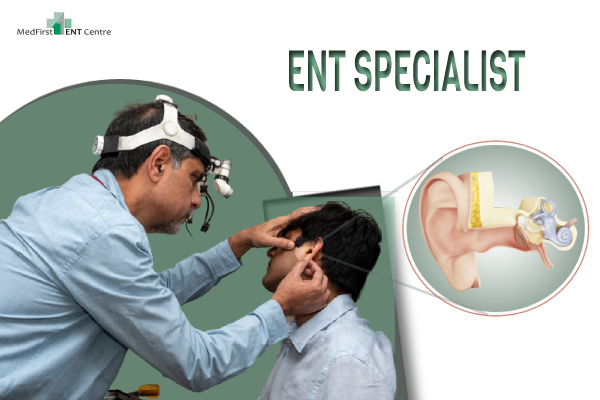Myringoplasty: repairing your perforated eardrums (Tympanic Membrane)
A common form of ear disease is Chronic Suppurative otitis Media (CSOM)
CSOM has largely ben broadly categorized into two types :-
TWO TYPES OF CSOM
- CSOM Attico Antral Disease – or unsafe CSOM – the ear disease can travel deep inside, damage surrounding tissues and can cause multiple complications including sensorineural hearing loss, facial nerve paralysis, giddiness, infection in the brain etc. This disease is usually caused by a Cholesteatoma and requires urgent attention, usually by a corrective surgery.
- CSOM Tubo Tympanic Disease – or safe CSOM – typically due to a central type of Tympanic Membrane perforation. This is usually, though not always, a safer kind of infection. The final treatment is repair of the perforated ear drum by a procedure called Myringoplasty.
Meaning
- Myringo- eardrum
- Plasty- repair of
Myringoplasty Versus Tympanoplasty – what is the difference?
Though very similar in approach and concept, a Myringoplasty is a simple repair of the ear drum, presuming the middle ear (including the ossicles) to be free of disease.
A Tympanoplasty consists of first visualizing the middle ear to look for disease, including the condition of the middle ear bones (Ossicles). If found defective, the ossicular chain is repaired and then the eardrum is repaired – so a Tympanoplasty is in effect a more comprehensive form of repair. It is a larger surgery than a simple Myringoplasty.
INDICATIONS
This surgery is performed for simple ear drum perforation when the following criteria are met
- Simple eardum perforation without ossicular disturbance
- Functional Eustachian Tube
- Adequate air-bone gap (difference between bone conduction and air conduction on an audiogram).
- The ear is dry- or at least not actively discharging – not mandatory but dry ears are usually easier to work with
APPROACHES
The following approaches may be used to perform the operation –
- Permeatal – via the ear canal
- Post Aural- incision is made in the groove behind the ear
- Endaural- the incision is made in front of the ear – between the pinna and the tragus
MICROSCOPIC VERSUS ENDOSCOPIC
The traditional method of performing a Myringoplasty is by using an Operating Microscope. There has recently been some interest in performing the surgery using a rigid telescope – the so called ‘Endoscopic Technique’.
Though the Microscopic technique is tried and tested with very gratifying results the Endoscope may offer some advantage in difficult to see areas since the microscope can only visualize in its direct line of vision. The Endoscopic technique however is usually a single hand technique.
The debate may settle by a ‘Hybrid’ approach where depending upon the requirement one or both techniques may be employed to offer the chances of the most favourable outcome to the patient.
ANAESTHESIA USED
The surgery can be performed under various anaesthetic techniques
- Local Anaesthesia – in young, willing patients, or in some patients where a General Anaesthesia is contraindicated for some reason
- MAC – modified Anaesthesia care – an Anaesthetist sedates the patient and takes care of pain and other discomfort
- General Anaesthesia – where the patient is made unconscious
SURGICAL STEPS
The surgeon follows the following routine steps
- Anaesthesia and incision
- Collection of graft material
- Freshening the edges of the perforation – as for any chronic non healing ulcer
- Lifting the Tympanomeatal flap- the skin of the ear canal along with the eardrum remnant
- Placement of gelfoam pledgets in the middle ear for support of the graft
- Placing the graft- usually under the annulus (the outer lining of the eardrum)
- Tucking in the graft and replacing the skin flap
- Applying dressing material in the ear canal and closing the wound
- A mastoid bandage is applied to cover the ear/ wound
Graft material used
The hole in the eardrum can be repaired by various materials which could be artificial or human tissue. Because of the body’s capability of graft rejection homologous material (from own body) is always the safest and best tolerated – reduces chances of graft rejection
- Paper- parchment paper can sometimes be used to repair a pinhole perforation with varied results
- Temporalis Fascia – probably the most common graft material used for repair of the ear drum.
- Perichondrium-usually from the cartilage in front of the ear
- Composite graft – consisting of cartilage plus perichondrium-taken from the tragus- the cartilage gives the graft stability and is also useful in covering canal wall/ attic defects or retractions
- Periosteum – specially in patients with subtotal perforations because periosteum lasts longer than other tissues or when other graft materials are not available.
Recently some other synthetic materials have been made available but they are not in common use.
POST OPERATIVE CARE
- First post operative visit is usually on 5-7th day after the surgery
- Bandage is removed, sutures are removed (if required)
- Ear pack is usually removed at 10-14 days
- There will be a feeling of wetness in the operated ear on account of the gelfoam etc.
- Recovery takes about 4-6 weeks
DOs and D’ONTS AFTER THE SURGERY
- Keep the operated ear and the dressing dry
- Take medication as advised
- Avoid air travel or pressure changes for 3-4 weeks after the surgery
- Call for guidance immediately in case of
- Swelling over the face/ ear
- Loss of movement of facial muscles on operated side
- Excessive pain
- Fresh bleeding
- Giddiness
Myringoplasty is a safe and effective surgery and has gratifying results in properly indicated cases.
Take good care of your ears to avoid any preventable injuries and trauma. Remember, you do not need to clean your ears, even with a cotton swab – the wax in your ears migrates outwards periodically. All you need to do is brush it out from outside the ear canal.

